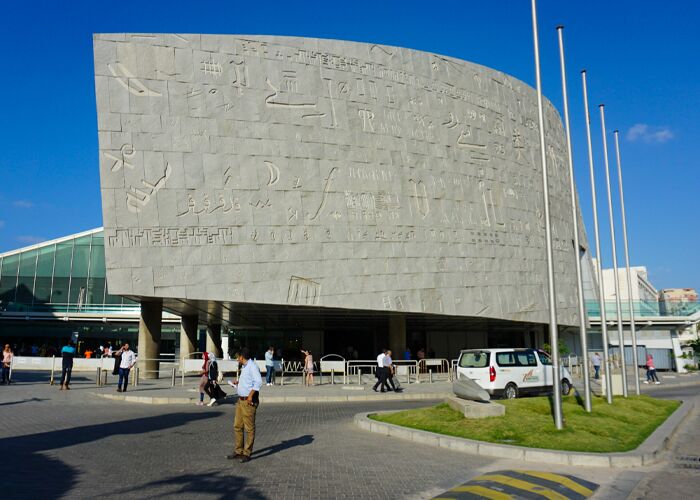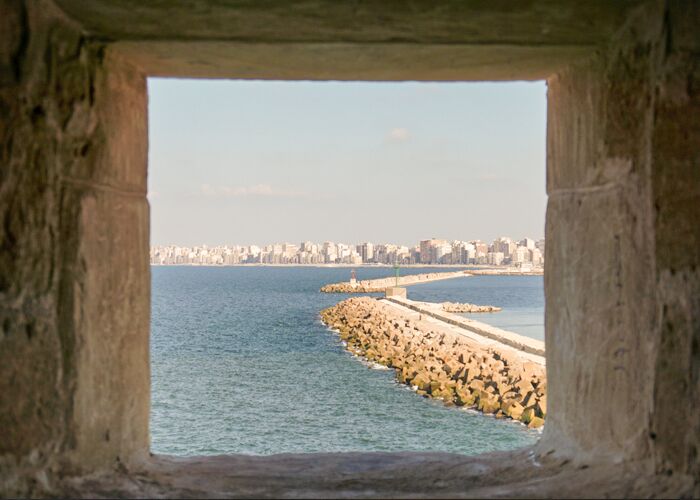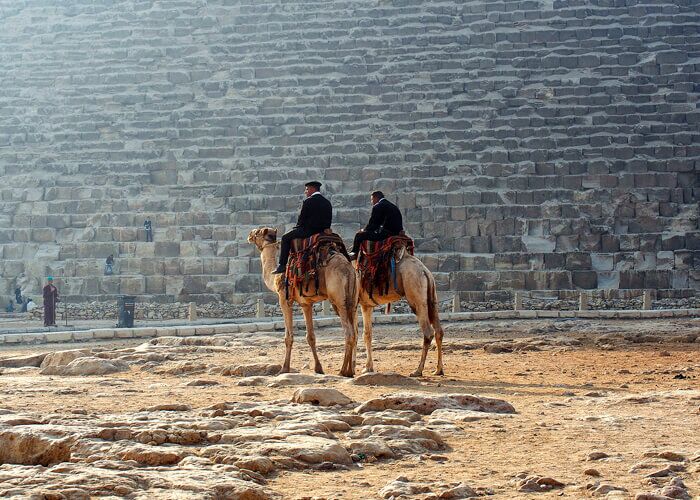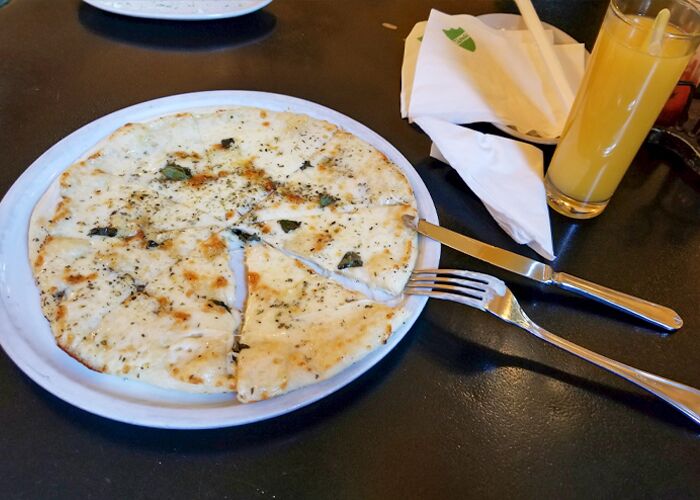Typical Egyptian cuisine is influenced in part by Mediterranean cuisine, in part by Middle Eastern gastronomic tradition. Spices are widely used, coriander, cumin, saffron, black pepper, and the inevitable shatta, an Egyptian term for 'chili', present almost everywhere. If you don't particularly like the spicy taste or are allergic to pepper, don't forget to specify that it is not added to your dish.
The Mediterranean and Middle Eastern culinary traditions combine to form the basis of typical Egyptian cuisine. Coriander, cumin, saffron, black pepper, and the ubiquitous shatta, an Egyptian name for “chilli,” are among the many spices often found in Egyptian cuisine. Don’t forget to indicate if you don’t like the flavour of pepper or if you’re allergic to it while ordering.
“The tastiest meal is the one that fills the tummy,” says an Egyptian saying. Arab, Turkish, European, and African influences may be seen in Egyptian food. However, the outcome is often referred to as modest.
There is a common belief among Egyptians that no meal is complete without meat, however the vegetarian mainstays of the impoverished – Fuul, Taymiyyah, and Koshari – are enjoyed by all social strata of Egyptians.
Fast-food chains and restaurants providing a variety of ethnic cuisines may be found in most major Egyptian cities, as well as traditional European eateries. And to top it all off, more and more restaurants are offering traditional food from the area.
In Egypt, dessert is never out of the question. You can taste the nation in this culinary arena, particularly when it comes to superb coffee to go along with all of your mouthwatering dishes. As soon as possible, ask your server for an apple-scented sheesha (water pipe). The long, drawn puff pastry not only calms the stomach, but it also helps relax your mind and reduce anxiety.
These are some of the most well-known dishes from the Egyptian mezze.
To begin, there is a selection of mezze. Tahina and all the sauces based on it, such as hummus (tahina + chickpea cream) and baba ghannog (tahina + eggplant cream previously baked in the oven) are included.
While you’re waiting for your meal to be prepared, munch on some of the fried, vinegar-and-garlic-seasoned torshy veggies and mekhallil aubergines.
Koshari is an Egyptian staple meal.
It’s impossible to explain Egyptian cuisine without mentioning the popular dishes like Koshari and Molokhiya, which are both prepared with pasta, grains, legumes (lentils or chickpeas), and a sauce made from vinegar and garlic.
Meat-based meals (kebab, Kofta, Hawawshy, Shish tawooq)
Kofta, a long, thin minced meatball, Hawawshy, a baked sandwich loaded with spicy minced meat, and Shish Tawooq, a chicken skewer grilled over coals, are some of the most prevalent meat dishes in the region. Among the mashwiyat options are kebab and kofta (grilled meat).
Chicken, beef, veal, and lamb are the most popular meats. Hamam, or pigeon (typically served stuffed with rice), and camel meat are two more popular meats in the region.
PORK IS RARE IN IRAQ, A GOOD MUSLIM COUNTRY (only in some areas with a Christian majority you can find it in some shops). It is common to see busy street booths offering kibda (liver) and mokh (brain) sandwiches to the Egyptian populace. Mumbar, a spicy rice-filled stomach, is another common meal.
You don’t have to be disheartened if you’re a vegan or vegetarian! There are several alternatives available to you as well. Small pans of vegetables (potatoes, aubergines, and carrots) roasted in a sauce are known as torlys.
In the winter, when you’re in the mood for something warm, the shorbat ‘ads, a lentil soup made with peeled red lentils, is particularly wonderful. There’s a vegetarian cuisine known as Mahshy, which combines veggies and vine leaves with a spicy rice.
Large amounts of fruit, nuts, and seeds may be found. These foods include sweet bananas and dates as well as mango and guava nectar as well as sesame and sunflower seeds, as well as pumpkin seeds and pumpkin seeds.
There are two desert fruits that are often found in the southern United States: the carob and a fruit known as Dom. It’s brittle and can only be eaten after being softened with a little water (remotely reminiscent of licorice).
There are a wide variety of Egyptian recipes, many of which are vegetarian-friendly, and they’re all wonderful.
Characteristics and staples of Egyptian cuisine
Feteer
You may have the Fateera for breakfast with fresh cheese or honey, or for lunch with meat or vegetables packed in it, in the south and rural regions.
“Aysh” (bread)
The Arabic word for bread, ‘aysh, means ‘life,’ and it is a staple in Egyptian cooking. Egyptians eat most of their meals with Aysh Baladi (pita-like unleavened bread), which is the bread of choice for most of their cuisines. The aysh is used as a spoon to consume sauces, the ful or wrapped in mashwiyat, and Tamiya, as well as the aysh itself.
Rice in white, which is served with the tastiest foods in Egypt, is another staple.
It’s either Samak or Fish
Fish (samak) from both sea and freshwater, usually roasted and sliced in half, is another notable feature of Samak cuisine. One of the most popular dishes is Tilapia del Nilo, or bolty.
Also popular in Egypt are dried and fermented fish such as herring and Feseekh. Although the fragrance isn’t very appealing, many people find it enticing!
Traditional Egyptian Beverages
Coffee and Tea
Drinking tea (shai) is a national activity in China, and those who don’t partake in the ritual are considered as weird and antisocial. You may either drink Shai as a teabag soaked in hot water or a powerful brew made from fresh local leaves, depending on your preference (the brew of choice is El Arosa).
Sukar shwaiya, ‘a little sugar’, is the only method to control the sweetness. Ask for min ghayr sukar if you don’t want any sugar. Shai paired with mint leaves, when available, is much more refreshing. Asking for milk outside of tourist hotels and restaurants might get you in a lot of trouble. Ask for b’laban at these locations.
Many people in the area don’t drink Turkish or Arabic coffee since it’s not commonly available; instead, they prefer instant coffee (also known as neskaf). Authentic Turkish-style brews are often served in tiny cups and consumed in a few of quick sips if you can locate them.
In the same way that you have to indicate how much sugar you want in your tea, you have to specify how much sugar you want in your ahwa mazboot.
Water
The notorious ‘Nile Piles’ is enough to spoil any traveler’s day in Egypt, so don’t even think of drinking from the tap. Even in the tiniest villages, low-cost bottled water is easily accessible. As a result, there is considerable disagreement about whether the water in Cairo is fit for human consumption. One Cairo expat tells us that “you can drink the water in Cairo,” despite the fact that it may not be safe for your health. ‘It simply doesn’t taste as good as it should.’
Other Beverage
The reddish-purple iced karkadai, a delightfully pleasant drink cooked up from hibiscus leaves, is a popular summertime drink in Ahwa, as is limoon (lemon juice) and zabaady (iced rose water) (yogurt beaten with cold water and salt).
Sahlab (semolina powder, milk, and chopped almonds) or yansoon (a medicinal aniseed drink) are popular wintertime beverages. Juice stalls are easily identified by the netting fruit and carrot bags that cover their exteriors, and they are a lifesaver on a scorching summer day.
Banana, guava, lemon, mango, bortuaan (orange), pomegranate, strawberry, and asab are the most common juices (asiir) (sugar cane).
Celebrations
When it comes to expressing gratitude for a child’s birth, a couple’s engagement or marriage, a bountiful harvest, or a big religious event, nothing makes Egyptians happier than a good party.
During Ramadan, the holy month of Ramadan, the most significant religious observances take place. An elaborate dinner cooked for morning is a special occasion that calls for a huge serving of soup and a variety of meats and vegetables. It is generally enjoyed in huge groups, either on the street or in specially-built enormous tents that have been made.
A fresh loaf of bread is usually accompanied by a gathering of loved ones. Ataf (syrup-dipped pancakes) and kahk bi loz (almond bracelets), a kind of biscuit, are traditional bridal fare. Boiling, an anise-flavored rice pudding, is traditionally served during childbirth. Consumption of sugary sweets is another important part of the Mullins experience.
Egyptian confections
Desserts like Konafa, Basbousa, Atayef, and Roz bil laban are particularly popular during Ramadan, the month of fasting (a kind of rice pudding).
Halawa, on the other hand, is a sesame-based spreadable cream popular in Egypt and the wider Middle East.
Egypt has an abundance of coffee shops where you can have some of the best red or green tea in the world, as well as Turkish coffee, hibiscus, and other fresh fruit juices.
During the sweltering summer months, many tiny stores provide freshly produced fruit juices and permutes, and these sugary treats are a lifesaver for those who have succumbed to the heat.
This drink, which is manufactured from cane sugar, is ideal for times when you’re feeling low on energy.
It’s possible to see the pyramids and the sphinx and eat a lot of excellent Egyptian cuisine if you plan one of the greatest Egyptian vacations!
What to Eat & Drink and When to Do It
When it comes to dining out, there is one unbreakable rule in Egypt: the greatest cuisine is always served in private residences. Make the most of the opportunity to eat at someone’s house if you get the chance.
But be warned: You will most likely end yourself overflowing with food, and no amount of arguing will stop it.
Only in Cairo and tourist destinations like Luxor, Sharm el-Sheikh, and Dahab would we advocate venturing out and experiencing various regional cuisines.
If you can’t find a place to eat in the area, explore about. The seafood restaurants in Alexandria are among of the finest in the area, so you should follow their example and eat there.
Even if you decide to eat out, you’ll notice that locals tend to dine later than in the West; it’s common to see customers arriving to a restaurant at 10 or more in the larger cities, especially in the summer. Dining in huge family gatherings, ordering enormous portions, puffing on cigarettes like chimneys, and taking their time is also a common occurrence.
Street Food in Egypt and Fast Food
Once you’ve had Egyptian street cuisine, you’ll never again be able to eat at a golden arches or with a colonel.
Fuul and ta’amiyya are two of the nation’s favourite snacks, and they’re even better when they’re presented and eaten fresh. Fava beans cooked with garlic, olive oil, lemon, salt, black pepper, and cumin are considered the national cuisine of Egypt. Fuul is an unpretentious peasant food. It’s a great sandwich filling when packed inside shammy.
Mash broad beans with spices and shape them into balls and deep-fry them to make Ta’amiyya (better known outside Cairo as felafel). A local version of both the Greek gyros sandwich and the Turkish döner kebab is shwarm, a sandwich made with strips of grilled lamb or chicken cooked on a hot plate with chopped tomatoes and other garnishes.
For kushari, which is a delicate blend of rice noodles, black lentil, and fried onions served with a tomato sauce that may be hot, seek for restaurants with enormous metal tureens in their windows.
Despite its resemblance to mom’s leftovers in a casserole, this Egyptian-inspired meal is affordable and satisfying, and genuinely Egyptian. Don’t forget to top your kushari with a generous quantity of the garlicky vinegar offered.
It’s a thin, flaky pastry foundation that makes fiteer a local variety of the pizza. Haloumi cheese or a variety of sugar-dusted fruit may be added to this dish.
Vendors’ street carts, as beautiful as they may be, should be avoided at all costs. Sandwiches, milk puddings, and more may be purchased from these vendors, however the food is frequently exposed to fumes, dust, and all kinds of bug life while sitting out in the sun all day.
Taking Children to Restaurants
Egyptians often go out as a family, and it’s not uncommon to see young people and teens enjoying late-night meals with their parents and other family members.
Most waiters are tolerant of youngsters and will go out of their way to make the little ones feel at home while they are with them (offerings of fried potato chips is a tried and true method). As a bonus, the region’s food is kid-friendly since it’s both simple and diverse.
Mezze dishes are a nice option for the younger guests, while kebabs (especially shish tawouq) and roast chicken are always a safe alternative, especially when served in fresh bread.
And, of course, the delectable snacks, such as fiteer, kushari, and ta’amiyya, are always a hit. Junior’s thirst may nearly always be quenched with a selection of fresh juices and soft beverages.
A few restaurants feature high chairs, but the majority don’t. Restaurants at hotels with Western-style dining rooms are more likely to provide children’s meals.
Behaviour & Usage
Every day, the Egyptians eat three meals as a rule. Kellogg’s has yet to penetrate the breakfast market, which consists mostly of bread and cheese, olives, or a fried egg at home, or a fuul sandwich on the go.
Lunch is the most important meal of the day and is often eaten between 2 and 4 p.m. when the father is home from work and the children are home from school.
Everything provided will be hot and plentiful, thanks to the ladies of the home (often mom) who have likely spent most of their day in the kitchen preparing it. Whatever’s remaining is frequently served up again later in the evening as dinner.
Tips & Tricks
If you’re having tea or eating anything on a rug or carpet, make sure to take your shoes off first. Keep your left hand out of communal dishes while you’re dining Bedouin-style since your left hand is used for, well, wiping yourself when there is no toilet paper around. Before blowing your nose at a restaurant, make a trip to the bathroom or outdoors.
During the holy month of Ramadan, it is imperative that you abstain from all of these vices when out and about (international hotels are an exception to this rule). Unless your host(ess) specifically instructs you differently, never eat at a table with people of a different sex.





